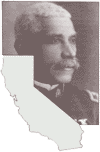![]()

Five Views: An Ethnic Historic Site Survey for California
MENU
Introduction
A.M.E. Church
Education
Industry
Farming
Business
Associations
Noted Individuals
Historic Sites
Selected References

A History of Black Americans in California:
HISTORIC SITES
John Scott's Ranch
Red Bluff, Tehama County
John Scott was born into servitude at White Sulphur Springs, West Virginia. When about 23 years old, he escaped slavery by taking refuge among the Indians. From the various Indian reservations that sheltered him, he made many trips into Tennessee, Kentucky, and Missouri to free relatives and friends. After about five years of freedom, Scott was captured and sold to United States Army Lieutenant Hoskins. In 1844, he was a slave member of Colonel John C. Fremont's California expedition. Several years after returning to the East, Scott again escaped, this time successfully ending any further servitude.
Heading west again, he was soon back in California where he stopped in Calaveras County and engaged in mining for a brief period. In 1859, Scott home steaded on half a section of land near Reeds Creek in Tehama County, just south of Red Bluff. It was here that he died May 19, 1916, at the age of 101 years.
Throughout his long residence, Scott gave generously of his time and resources to support activities intended to benefit the Black community.
In 1866, together with several other Black Tehama County residents, he helped establish the county's first colored public school, which was maintained by subscription. At this period in California's history, state law forbade admission of Black children to regular public school systems. School districts had the discretionary power to establish "colored schools" with general school funds, if 10 or more children applied. However, Red Bluff's school trustees did not make such a decision, even though the town at the time was pro-Union. Pro-Union sympathies were so strong that John Brown's widow elected to settle in Red Bluff after the Harper's Ferry incident. Sarah Brown, Brown's daughter, also taught in the "colored school," but the trustees did not choose to end segregated education.
NEXT> Lower Presidio Hill
Last Modified: Wed, Nov 17 2004 10:00:00 pm PDT
5views/5views2h60.htm
 Top
Top